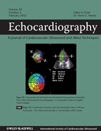Role of Left Ventricular Dyssynchrony in Predicting Remodeling after ST Elevation Myocardial Infarction
Conflict of Interest: Authors have no conflict of interest to disclose.
Abstract
Background: Intraventricular dyssynchrony is associated with worsening systolic function, adverse remodeling, and clinical events. The aim of this study is to investigate whether intraventricular dyssynchrony assessed by tissue Doppler imaging (TDI) can predict left ventricular (LV) remodeling after first ST segment elevation myocardial infarction (STEMI) treated successfully with primary percutaneous coronary intervention (pPCI). Methods: Fifty-two consecutive patients who presented with first acute STEMI were included in the study. All patients underwent successful pPCI. Standard echocardiography was performed within 48 hours of admission. LV dyssynchrony was assessed by color-coded TDI. Dyssynchrony (Ts-diff) was calculated by maximal temporal difference between time to peak systolic velocities (Ts) of six basal segments. Echocardiographic examination was repeated after 6 months to reassess LV volumes. LV remodeling was defined as >15% increase in LV end-systolic volume index (LVESVI) after 6 months. Results: Eleven patients (23%) developed LV remodeling. Baseline dyssynchrony was found to be correlated with percent change in LVESVI and LV end-diastolic volume index (LVEDVI) after 6 months. Ts-diff, creatine kinase-MB and mitral inflow E-wave deceleration time (DT) were the independent predictors of remodeling after STEMI in multivariate logistic regression analysis. Receiver operating characteristic curve analysis showed that Ts-diff >56 msec had 72.7% sensitivity and 83.8% specificity for predicting remodeling. Conclusions: LV dyssynchrony is a strong predictor of LV remodeling after acute myocardial infarction (AMI). It could be useful in risk stratification of patients after AMI. (Echocardiography 2012;29:165-172)




